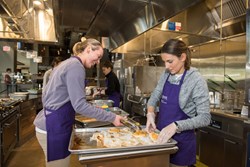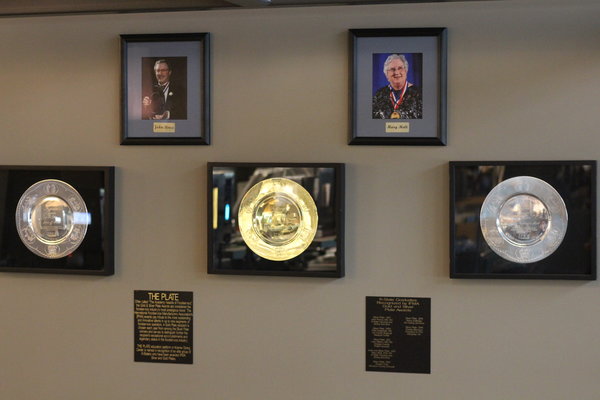
Kansas State University is home to seven alumni who have received IFMA Gold & Silver Plate Awards during the last 30 years. K-State believed it was appropriate for their new teaching platform and dining facility where future foodservice leaders are educated, to be named ‘THE PLATE’, in recognition of the IFMA Gold & Silver Plate Awards. THE PLATE received its name because of Kansas State’s Housing and Dining’s relationship as teaching partners in the food production management education of students, in hospitality management and dietetics.
In addition to the current dining management directors who have received IFMA Plates, other recipients include; John Pence (1987), Patty Dollarhide (2004), Lora Gilbert (2011), Mary Molt (2012), Sandra Ford (2014), Nona Golledge (2015) and Charlie Morrison (2016). All plate winners’ names are prominently displayed in the area in hopes of providing encouragement for students to work toward distinguishing themselves as leaders in the foodservice industry.
About THE PLATE
Educating future foodservice leaders has been ongoing at Kansas State University for nearly 150 years, soon after the university was established as the first operational land grant institution under the Morrill Act of 1862. Food production education was well established and in 1926 when the first residence hall was built, the hall’s dining director was an assistant professor and she, along with the dean of then Institutional Economics, prepared students for foodservice management careers using the dining service as a real-world teaching laboratory. The model for teaching students in foodservice careers continues today with dining services faculty and administrators working with their academic faculty colleagues to teach supervised practice classes.

A teaching platform in a new dining facility was included from the very beginning of the planning. The space is intended to be used for teaching in several ways:
- Classes in food production management taught by dining services management professionals, also faculty members in the College of Human Ecology would use the space for teaching the laboratory or supervised practice component of classes.
- Dietetics students completing their final management semester use the space for course work assignments such a planning, preparing and serving special events. The space is used also for value analysis projects and has a planned use for students teaching classes related to cooking (demonstrations) and nutrition.
- Culinary workshops are also planned for the future. These workshops will be full day events and include both outside guests, residents living in the residence halls, students in our food related academic programs and staff. Guest Chefs will be invited to teach these workshops.
- The space is designed for residence hall student programming and educational activities. For example, students request to learn low fat cooking methods, knife skills, etc. can be accommodated in THE PLATE space.
- Employee education programs are an intended use of the space.
- With a student customer base of 1800, the food that is prepared in the teaching space is quickly incorporated into the meal’s menu and thus the food cost expense for student teaching and other special programs becomes part of the operations costs and not specifically the cost of the program. Student residents living in the residence halls enjoy the food that is produced in the teaching area. The dining spaces are located so students not specifically involved in the education area can observe and listen to what is happening in THE PLATE teaching platform and the food produced can easily be served in adjacent locations.
Attributes of the space:
- Equipped with a full battery of commercial cooking equipment: Steamers, Combi Ovens, Tilting Fry Pan, Steam Jacketed Kettle, Deep Fat Fryer, Gas Range Top. Hot and cold holding equipment and very attractive serving spaces are in the platform.
- The dining space is in a semi-secluded area of the dining room with the audience space tiered for easy viewing of the production area.
- The space is equipped with cameras and two large TV screens for projecting live the events happening on the production stage. The production space is situated in front of the audience and intended to make the area engaging and fostering audience-presenter interaction.
